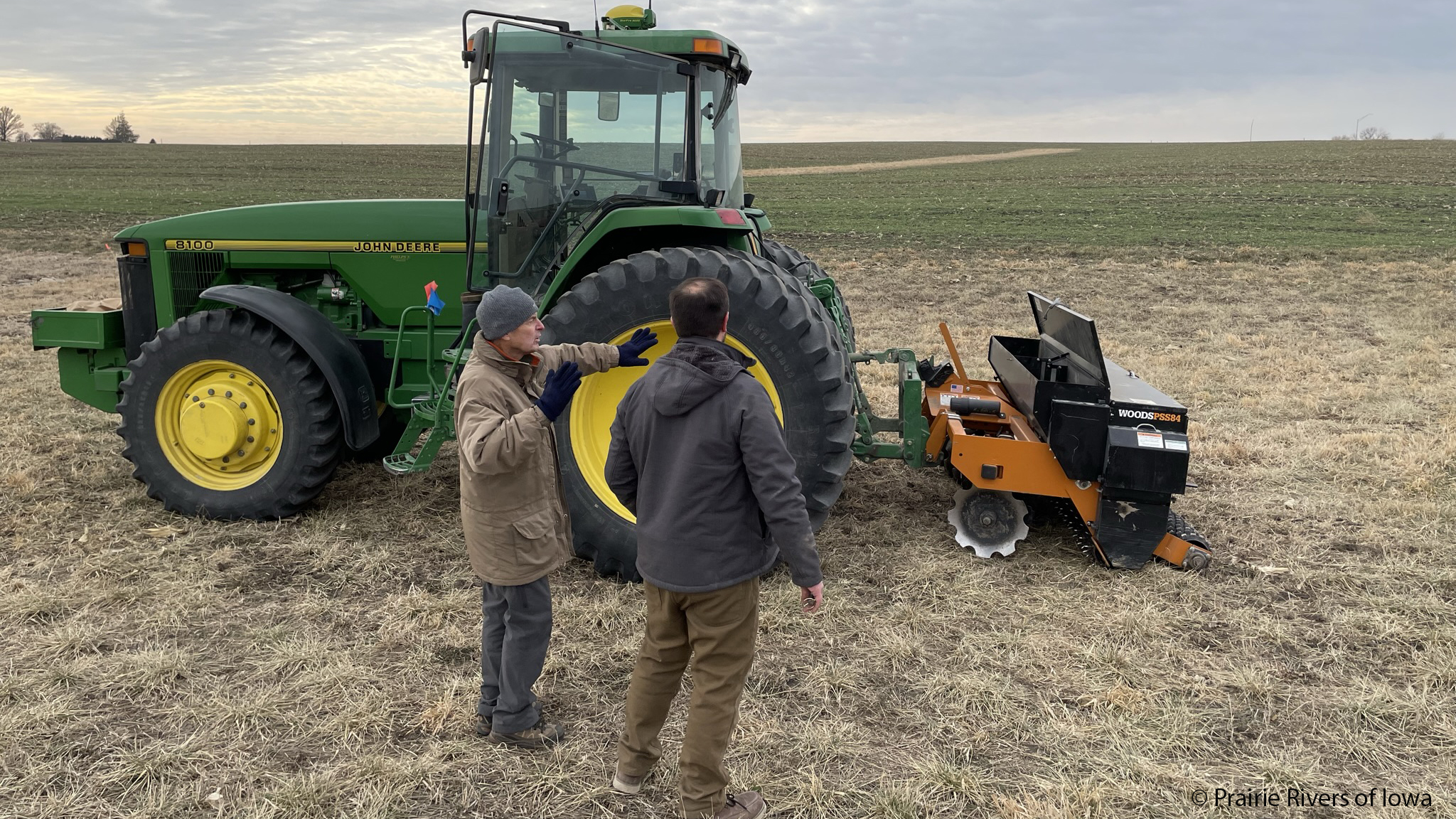I turned my dusty Ford Ranger off a quiet two-lane highway in Marshall County into a dead grass waterway, soon to be planted with native prairie seed. I pulled up next to Chuck’s vehicle.
“Well, today’s the day, isn’t it,” he said, smiling despite the icy November wind. We were finally putting seed in the ground.
A Rough Start
It can take more effort than you think to plant a prairie in a grass waterway. Firstly, Chuck Stewart, of Ankeny, doesn’t live in Marshall County; he rents his field to a farmer, who plants traditional crops like corn and soybean. Secondly, the grass waterway was planted with smooth brome (a tough European grass), making it difficult to plant anything else in it. Lastly, the previous landowner had created the grass waterway without using any government programs. This last fact made it difficult to qualify for USDA programs to help fund the cost of planting a prairie strip in the waterway. Many NRCS and FSA (Farm Service Agency) programs stipulate the ground must be currently in production to receive funding. Landowners who don’t qualify for NRCS and FSA programs, like Chuck, can have a difficult time finding programs to fund prairie projects on their land.
“The reason I started this prairie project was to establish a site that will draw not only pollinators but all kinds of wildlife,” said Chuck. In order to do this, he needed expertise from environmental-based organizations, such as Prairie Rivers of Iowa.
Finding a Way
Although he could not receive funding from traditional USDA programs, Chuck did, however, have a few things going for him. He initially had David Stein, a former watershed coordinator at Prairie Rivers, conduct a site visit and create a restoration plan.
“Prairie strips [are] one of the best ways farmers can get into conservation practices and habitat building,” David Stein said when asked about this project, “You’re taking unproductive land out of intensive use and replacing it with a small area that provides amazing benefits for the farm and surrounding environment.” For Chuck, some of those benefits include a reduction in runoff and erosion, increased water infiltration, and of course the perennial beauty of native prairie, pollinators, and other wildlife.
Additionally, Chuck was able to secure a 50% cost share from the Prairie Partners Program to reduce the expense of native seed. Chuck also had a neighbor, Henry, who had some prairie-planting experience and owned a native seed box for his tractor. Having a willing, experienced neighbor to help plant and manage the future prairie made this project much more cost-effective than hiring someone out of town.
Lastly, Chuck and I met with Dan Allen, the owner of Allendan Seed Company, to see the operation that supplied his native prairie seed. After viewing giant warehouses of seed, expansive fields of prairie plants, and a large greenhouse, we discussed how to help the prairie outcompete the smooth brome currently in the grass waterway. Knowing it may take a few years to truly defeat it, we decided to mow the smooth brome and hit it with two rounds of glyphosate, at about a month apart, before planting the prairie seed in the fall. We also added another seed mix in addition to the one cost shared with the Prairie Partners Program. While this was an out-of-pocket expense, planting higher than the minimum of 40 seeds per acre, as well as increasing plant species richness, will hopefully provide faster and stronger establishment, giving the prairie a greater chance at success in the long run.
Seeds of Hope
As Chuck stepped down from the tractor at the end of planting, it was hard to imagine that the dull-gray strip of land would one day be full of color and life.
“We did it!” He said with a grin, “I hope the neighboring farms will see the results and consider planting prairie themselves.” It is our hope that more farmers will see the value of turning silent areas into vibrant habitat, with bird calls, bees, and dancing flowers breaking the monotony of row crops.
If you are interested in implementing prairie on your property, and are unsure of where to start, contact Jessica Butters, Pollinator Conservation Specialist, at Prairie Rivers of Iowa, HERE.
Many Thanks:
“In summary, I want to thank Prairie Rivers of Iowa staff David Stein and Jessica Butters. David developed a detailed plan outlining the process, and Jessica prepared an outline for the timing of each step, from preparing the seedbed to the ongoing steps of maintaining the prairie.” – Chuck Stewart
We would also like to thank Henry Rolston, Allendan Seed Company, Jon Judson, and Ty Mason.







